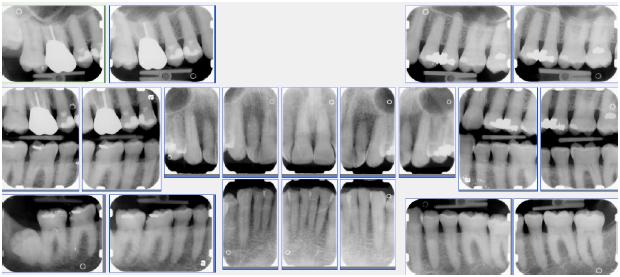Services
When gums are healthy, there are only small, shallow spaces around each tooth. When bacterial plaque is left at the tooth/gum junction, the resulting infection (periodontitis) causes these spaces to become deeper. As the “pockets” (spaces) deepen, the bacteria grow in number resulting in red, swollen, bleeding gums and frequently bad smelling breath, and bone loss. When spaces become deep, a procedure of pocket reduction may useful. The procedure removes the bacteria and infected tissue, cleans and smoothes the root surfaces, and reshapes as necessary the bone and gums surrounding the teeth. All this allows the gums to heal with shallower, more cleansible, and healthier spaces.
Functional crown lengthening is a procedure performed when there is not enough exposed tooth structure upon which to place a restoration. It is often done when a tooth fractures at or below the gumline or when the tooth is significantly decayed. In order to save and properly restore the remaining tooth, a periodontist may remove gum tissue and/or bone to expose more healthy tooth structure. As a result, a crown-lengthened tooth will probably appear longer, since more of the tooth has been exposed.
Jawbone volume can be lost due to periodontal disease, tooth loss, pressure from dentures or partial dentures, trauma, injury, or atrophy. This results in unsightly deformities or indentations in the bone which can produce an unattractive restoration, a cleansibility problem, or an inability to place dental implants. Hard and soft tissue reconstruction — to build back lost structure — is an effective procedure to either prevent volume loss or remedy it, thus improving appearance, allowing dental implant placement or both.
With periodontitis (gum disease), teeth can lose supporting bone resulting in loose teeth, a change in the way teeth fit together and function, and eventual tooth loss. Sometimes the underlying boney architecture will allow the bone to be rebuilt. Based on the best clinical research and a great clinical skillset, Dr. Newhouse uses the either materials from the patient’s own mouth or processed banked materials with biologics (proteins that speed healing) and resorbable membranes to reconstruct the loss jaw structure, tighten teeth, reestablish function, and save teeth. Dr. Newhouse has done thousands of such procedures and saved thousands of teeth!
Digital Photography – extraoral and intraoral. It lets us look forward and backwards. It shows what we start with and it lets us evaluate outcomes. It helps us convey conditions and circumstances to our patients, their insurance companies, colleagues, and students.
If you are missing a single tooth, a crown restored dental implant is the most natural looking way to replace it. It functions like a natural tooth and unlike a bridge, it doesn’t involve neighboring teeth. An implant preserves the bone, so naturally looking jaw contours are maintained. What’s more, a single-restored dental implant is much easier to clean and does not catch food like a bridge. And it doesn’t get cavities!
Dental implants represent some 70 years of dental engineering and research. Dental implants can be a natural-looking and functional solution to tooth loss. Ideal for single-tooth replacement, a crown-restored dental implant can be a very aesthetic and practical choice. It can not only blend seamlessly with your natural teeth, but also preserves natural tooth and jaw structure which ultimately maintains your facial contours.
Healthy gums form the “picture frame” for the teeth. They also protect the teeth against decay. Root exposure or recession makes the teeth look long and unattractive. Recession can also make the teeth sensitive to hot, cold, or touch. By recovering the roots and rebuilding the lost gum tissue, recession can be reversed, sensitivity decreased, and decay susceptibility reduced, resulting in a younger, prettier smile.
For those with multiple missing teeth, implant-supported bridges or multiple individually restored implants can offer a permanent, cavity-resistant solution. These options ensure full functionality without compromising neighboring teeth, effectively preserving your smile and facial structure.
Sometimes, teeth cannot be saved for a variety of reasons – cracks or fractures, root canal failures, teeth whose structure can’t be restored, or impacted teeth associated with adjacent teeth. When this is the case, Dr. Newhouse can remove the teeth and perform socket regeneration so that the dimensions of the jawbone can be protected. Without such socket regeneration as much as 30% of the jawbone dimensions in all directions can be lost. Protecting the bone’s width and length becomes important for implant placement, for other types of esthetic tooth replacement, and for the bone support of adjacent teeth. In the end, it provides the foundation for model smiles and health!
1 in 6 American adults have complete tooth loss. For these individuals, implant-supported dentures or bridges offer a life-changing solution. These comprehensive restorations go beyond mere aesthetics. They support jaw structure and volume, enhance facial structure, and can improve overall quality of life. Patients, regardless of age, can rediscover the joy of a fully functional smile, enjoy their favorite foods, and engage in social interactions with newfound confidence.
Sometimes teeth look short and square and have what might be termed a “gummy” appearance. Teeth are typically thought to be more esthetic if they are longer than they are wide. Gum tissue can be reshaped so that all of the enamel portion of the tooth is exposed, creating a more attractive tooth shape. Gum recontouring can be done without unexpected changes to the natural tooth. And having this procedure prior to preparation and placement of crowns or veneers makes for the “prettiest” smiles!
On your first visit to our office, we will learn about your current and past dental health, listen to your concerns, and discuss your treatment goals and overall wellness needs. Then, we will perform one of the most thorough dental examinations you’re likely to have ever experienced in order to help you learn about your dental condition and provide customized options for treatment of your specific needs. We want you to feel at ease during your visit. We’ll help you be as comfortable as possible as we provide options for treatment that work best for you while achieving your healthcare goals.

Imagine one hour to whiten teeth. That’s because, at Newhouse Periodontics, we use Philips Oral Healthcare’s Zoom!® chairside bleaching system. With this system, our patients with average teeth typically see a lightening of 3 to 7 shades with a single application. The entire process takes about one-and-one-half to two-hours from start to finish, though the actual bleaching process takes about an hour. And while results of how white you can get your teeth vary from patient to patient, we’re sure you’ll love the results.
Early to moderate periodontitis can be predictably treated with scaling and root planing (“deep cleaning”) in conjunction with effective homecare. Ideally, plaque, calculus (tartar), and stain are removed both above and below the gumline. It can easily be accomplished with topical and/or local anesthetics. Afterward, the “gums” might be a little sore with homecare for a couple of days. Typically, even this limited soreness can be managed effectively with a couple of doses of ibuprofen or Tylenol.
Sometimes, Dr. Newhouse will place antibacterial microspheres (Arestin) or an antimicrobial gel (Atridox) in the pockets (spaces between gums and teeth) as an adjunct to non surgical treatments. These materials may enhance the effects of the scaling and root planing.
Periostat (low dose doxycycline), an oral medication, may also be used to minimize further loss of tooth attachment and improve resistance to further infection.
Invisalign® is a method of tooth movement using custom made clear smooth aligner “trays” to straighten teeth. They are made of invisible plastic that you wear over your teeth. This method of treatment helps correct conditions like crowding, spacing, deep bites, open bites, crossbites, narrow arches, and midline discrepancies. Invisalign® works without brackets, bands, or wires to gradually move teeth into the desired position. Because the aligners can be easily removed at any time, you can pop them out to eat, drink, and perform effective brushing and flossing. They are comfortable to wear and do not irritate cheeks and lips. And, since they are virtually invisible, no one knows you’re wearing them. Typical Invisalign® treatment takes about a year from start to finish.
Everyone that seeks care at Newhouse Perio gets a complimentary oral cancer screening as part of a comprehensive periodontal examination. According to the American Dental Association, more than 42,000 Americans received an oral or throat cancer diagnosis in the last year. Often patients don’t realize there is anything to have evaluated until the cancer is advanced since such areas may not hurt. Because early detection and timely treatment can help save lives, Newhouse Perio thinks it is important to have oral cancer screening exams at each examination appointment – whether you are a new patient or one in a maintenance program.
Oral cancer screening does not hurt and are easy to do. If you are a smoker, use alcohol heavily, or have a history of lots of sun exposure, you may be at greater risk for oral cancer. Cancers can occur on the tongue, under the tongue, hard or soft palate, gums, inner surfaces of the cheeks, or the lips. If a suspicious area is observed, Dr. Newhouse may recommend a biopsy.
A frenum is a small fold of tissue that attaches the gums to the inner lips, cheeks, and tongue. At times, these attachments cause pulling on the gums when the cheeks, lips, or tongue are moved during everyday activities like eating, speaking, or brushing. Over time, these “pulls” cause the gums to recede or shrink away from the tooth causing root exposure or can even cause undesirable spaces between teeth.
A frenectomy is a procedure where the frenum is repositioned so that it no longer creates tension on thin tissue or keeps teeth apart. It is a simple procedure that is typically done with local anesthetic so there is no procedural pain. There is with little to no post-surgical discomfort or swelling.
Because Periodontal Diseases are chronic problems, like diabetes, ongoing health assessments and periodontal cleanings are necessary to maintain wellness, regardless of the active therapy (either nonsurgical or surgical) already accomplished. Maintenance intervals vary from person to person, but are typically more frequent than the 6 month intervals recommended for patients with no history of “gum” diseases. Following your initial periodontal treatments, Dr. Newhouse will determine the interval that is “right for you” to maintain periodontal health.
Part of looking and feeling good is not to have bad breath impact your interactions with others. 50% of adults have halitosis (bad breath). Frequently the person with bad breath does not know he/she has it because those around him/her do not feel comfortable in telling the person that they have it. Because causes of bad breath vary, the source first needs to be identified in order customize the treatment for it. Bad breath can be related to gum disease, tooth decay, ineffective oral hygiene procedures, foods, bacteria associated with the tongue or tonsils, stomach problems, sinus issues, diabetes, smoking, and dentures to name a few.
Dr. Newhouse can identify the source or possible sources of a person’s bad breath and then develop a personalized treatment program to target the problem and eliminate the odor.
 Our i-CAT Precise CBCT machine provides us three dimensional views of oral structures rather than just the traditional two dimensional views that dentists have relied upon for the last hundred years. It helps guide us through potential surgical complications, and identify structures that are abnormal and potentially matters of concern. CBCT data lets us place implants with a high level of safety and confidence, and allows us to provide surgical services with a high degree of comfort about the actual position of anatomic structures.
Our i-CAT Precise CBCT machine provides us three dimensional views of oral structures rather than just the traditional two dimensional views that dentists have relied upon for the last hundred years. It helps guide us through potential surgical complications, and identify structures that are abnormal and potentially matters of concern. CBCT data lets us place implants with a high level of safety and confidence, and allows us to provide surgical services with a high degree of comfort about the actual position of anatomic structures.

Digital Radiography Has Revolutionized the Way Dental Care is Provided!
Digital radiography has been a part of Newhouse Periodontics for over a decade. Not only does it provide us the opportunity to save, transmit, and review radiographs without loss of quality over time, but it also allows us to expose our patients to MUCH less radiation because of the added sensitivity of the digital media.











